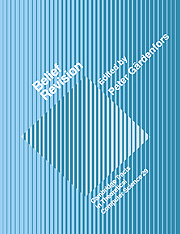Book contents
- Frontmatter
- Contents
- Belief revision: An introduction
- Reason maintenance and belief revision: Foundations versus coherence theories
- Syntax based approaches to belief revision
- A dyadic representation of belief
- On the logic of theory change: More maps between different kinds of contraction functions
- Belief change and possibility theory
- On the difference between updating a knowledge base and revising it
- Planning from first principles
- Autonomous belief revision and communication
- Conditionals and knowledge-base update
- Index
Conditionals and knowledge-base update
Published online by Cambridge University Press: 21 September 2009
- Frontmatter
- Contents
- Belief revision: An introduction
- Reason maintenance and belief revision: Foundations versus coherence theories
- Syntax based approaches to belief revision
- A dyadic representation of belief
- On the logic of theory change: More maps between different kinds of contraction functions
- Belief change and possibility theory
- On the difference between updating a knowledge base and revising it
- Planning from first principles
- Autonomous belief revision and communication
- Conditionals and knowledge-base update
- Index
Summary
Knowledge update has been a matter of concern to two quite separate traditions: one in philosophical logic, and another in artificial intelligence. In this paper we draw on both traditions to develop a theory of update, based on conditional logic, for a kind of knowledge base that has proven to be of interest in artificial intelligence. After motivating and formulating the logic on which our theory is based, we will prove some basic results and show how our logic can be used to describe update in an environment in which knowledge bases can be treated as truth-value assignments in four-valued logic. In keeping with Nuel Belnap's terminology in Belnap (1977a) and Belnap (1977b), we will refer to such truth-value assignments as set-ups or as four-valued set-ups.
Paraconsistency, primeness, and atomistic update
For the moment we will not say exactly what a four-valued set-up is. Instead we will describe informally some conditions under which it would be natural to structure one's knowledge base as a four-valued set-up. One of these conditions has to do with the treatment of inconsistent input; a second has to do with the representation of disjunctive information; the third concerns what kinds of statements can be the content of an update.
Inconsistent input
A logical calculus is paraconsistent if it cannot be used to derive arbitrary conclusions from inconsistent premises. Belnap argues in general terms that paraconsistent reasoning is appropriate any context where an automated reasoner must operate without any guarantee that its input is consistent, and where nondegenerate performance is desirable even if inconsistency is present. Knowledge bases used in AI applications are cases of this sort.
- Type
- Chapter
- Information
- Belief Revision , pp. 247 - 275Publisher: Cambridge University PressPrint publication year: 1992
- 11
- Cited by

